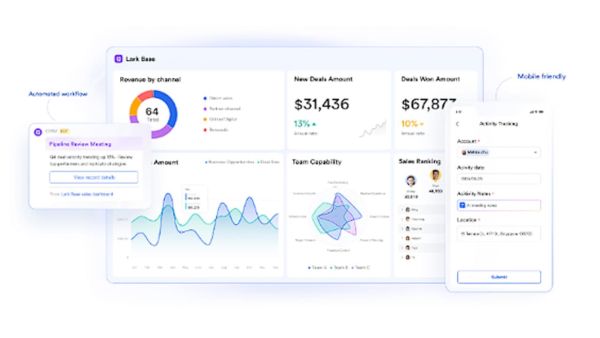
To be able to be agile, you need a strong base. Lark Base makes it easy to understand how data, workflows, and projects are set up, but you can still change them if you need to.
In the business world today, being huge or having a lot of resources isn't enough to give you an edge. It's also about how fast you are. Businesses that can quickly adapt to changes in the market, customer needs, and rules always do better than their slower competitors. But having structure without flexibility makes things excessively stiff, while having speed without structure leads to mistakes. The answer is a connected platform that brings them both together.

The best project management tools help companies achieve the right mix between speed and structure by bringing together communication, workflows, and decision-making. One of these platforms is Lark, which helps businesses become more strategically adaptable so they can stay ahead of their rivals.
Lark Base: Building adaptable structures for rapid response
To be able to be agile, you need a strong base. Lark Base makes it easy to understand how data, workflows, and projects are set up, but you can still change them if you need to.
Base helps sales to maintain track of leads, customer chats, and opportunities, operations to keep track of supply chain data, while finance can keep track of spending, depicting features that are similar to that of a CRM app. This merging makes sure that leaders can see all they do.
Functions of Lark Base:
- Dashboards: Show leaders performance data in real time so they can instantly see risks or chances.
- Linked records: Connect contracts, projects, and tasks so that information can move freely between departments.
- Custom fields: You can change monitoring to meet the needs of your business, from sales KPIs to ensuring sure suppliers follow the laws.
- Different views: Kanban, grid, or Gantt let teams keep track of projects in the way that works best for them.
- Centralized database: This cuts down on duplication and gives you a trustworthy, one source of truth, which makes it easy to make quick judgments.
Lark Messenger: Turning communication into action
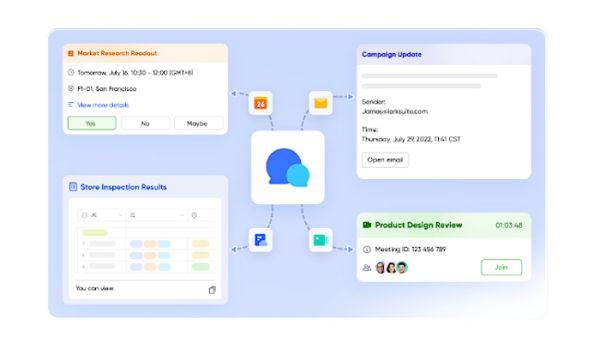
Lark Messenger
When communication is cut off, things move more slowly. Lark Messenger makes sure that conversations don't get lost; instead, they lead to action.
Functions of Lark Messenger:
- Threaded conversations: Keep project updates in one place so that there is less confusion and time is saved.
- Pinned messages: Keep key updates or decisions in view of the whole project.
- Mentions: Get the relevant people involved in negotiations right immediately so that there are no delays in getting back to you.
- Built-in translation: This feature quickly breaks down language barriers so that teams from different nations may work together more easily.
- Chat-to-task: Make important communications into jobs that need to be done immediately. This makes conversations more accountable.
Lark Calendar: Synchronizing global timelines

Lark Calendar
Being agile depends a lot on timing. When teams' schedules aren't in sync, they waste time and energy trying to fulfill competing deadlines or unmet obligations. The Lark Calendar makes things more regular and easy to plan for.
Functions of Lark Calendar:
- Shared calendars: Make sure everyone in the workplace knows about crucial deadlines, milestones, and when they are available.
- Time zone conversion: Automatically updates timetables for teams all over the world, which cuts down on back-and-forth.
- Reminders: Keep people and teams on track by making sure they don't miss deadlines.
- Linked events: Connect meetings to Docs or Base records so that the interactions are always current.
- Cross-team visibility: This makes sure that everyone in the company knows the same thing about schedules, which enables them all react to changes at the same time.
Lark Approval: Accelerating fair decision-making
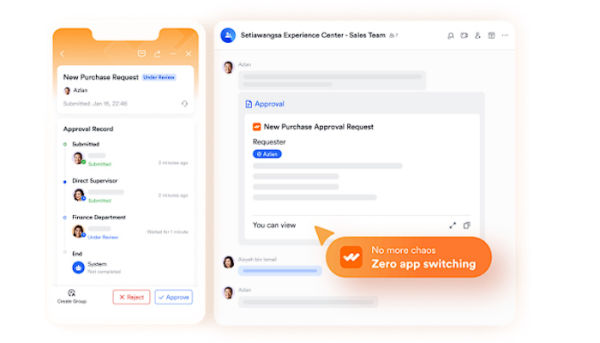
Lark Approval
When decisions get caught in inboxes, everything slows down. Lark Approval ensures that requests and approvals are handled quickly and fairly, without infringing any rules.
Functions of Lark Approval:
- Standardized forms for requests: This makes it easy to submit requests and makes sure that everyone is on the same page.
- Approval overview: Gives managers clear visibility into pending requests, helping them review and prioritize efficiently.
- Role-based permissions: Keep private data safe while letting people see it when they need to.
- Decision logs: Keep a full record of all approvals so that you can be held accountable and follow the rules.
- Automated workflow: Sends requests immediately to the right personnel, which cuts down on delays and speeds up the process.
Lark Docs: Creating living records for collaboration
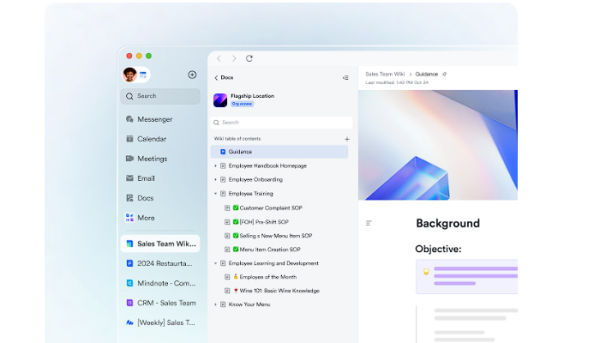
Lark Docs
When there are different versions of documents, it usually takes longer to make strategic judgments based on them. With Lark Docs, teams can work together in real time in a shared, changing place.
Functions of Lark Docs:
- Real-time co-editing: Teams can edit at the same time, which cuts down on delays caused by waiting for versions.
- Inline comments: Feedback is written down in a style that is easy to understand, which speeds up the search for a solution.
- Version history: Keeps track of changes and enables teams to go back if they need to, which makes sure everyone is responsible.
- Embedded content: To maintain the context up to current, add live Sheets or Base records to documents.
- Access controls: Only the right people should be able to read sensitive reports.
Lark Sheets: Turning data into immediate insights
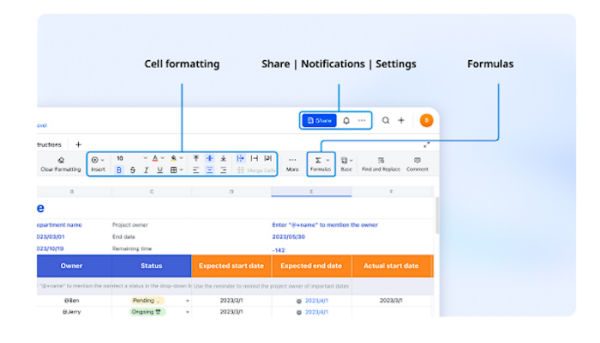
Lark Sheets
Data helps you make quick decisions, but it takes longer to acquire insights when spreadsheets are split up. People can work together on analysis in real time and with confidence because of Lark Sheets.
Functions of Lark Sheets:
- Editing at the same time: More than one person can modify data at the same time without producing problems with versions.
- Advanced formulas and pivot tables: Quickly uncover trends to inform fast decisions.
- Audit trails: Keep track of who made changes and when to ensure sure everyone is accountable.
- Putting in Docs/Base: This connects analysis to action, so the data isn't kept separate.
- Access from the cloud: Keeps data current and accessible from anywhere, which is perfect for teams that operate from multiple areas.
Lark Wiki: Preserving agility through institutional knowledge
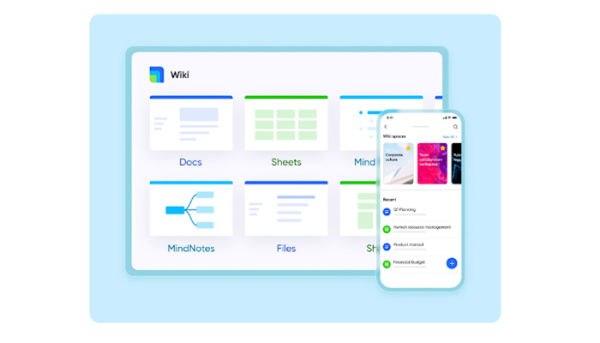
Lark Wiki
Agility diminishes when knowledge is kept in separate places or lost. Everyone in the firm may always access and use Lark Wiki's lessons, processes, and best practices.
Functions of Lark Wiki:
- Centralized knowledge base: This is where all of the policies, playbooks, and procedures are kept.
- Instant updates: Changes are reflected immediately across the organization.
- Search function: Helps you find useful information quickly and easily.
- Permissions: Make sure that sensitive data is safe but easy to get to when you need it.
- Onboarding resource: This gives new employees rapid access to all the information that has been collected, which helps them get up to speed faster.
Conclusion
Being strategically agile doesn't imply moving rapidly. It means having systems that make speed reliable. Tools that don't work well together can make things go wrong, duplicate work, and slow things down. Unified platforms like Lark change this by making all workflows faster and more organized.
Base combines records with the flexibility of a CRM. Messenger makes communication useful. Calendar syncs timelines. Approval speeds up decisions with automated workflow. Docs keep documents up to date. Sheets turn data into insights. Wiki keeps institutional knowledge alive. These traits work together to help organizations respond faster than their competitors and build strength for the future.
It's apparent what leaders need to do: being flexible isn't something that just happens; it's something you have to work on. When businesses connect their systems, they can switch from reacting to a situation to planning how to deal with it.
-
HIV AIDS: How the risk of HIV increases, understand stage by stage how dangerous its symptoms become.

-
Over 3,000 cases, arrests in Ernakulam Rural District police crackdown on drug activities

-
Poundland closing 11 high street stores with 2 shutting next week - full list

-
BREAKING Alejandro Garnacho hooked at half-time after furious Chelsea star screamed at him

-
4 painting hacks everyone should know before redecorating
